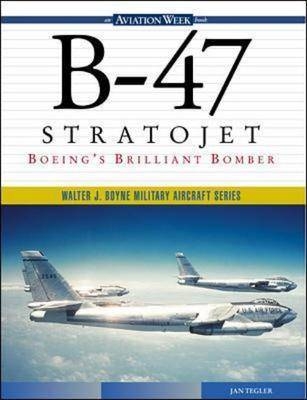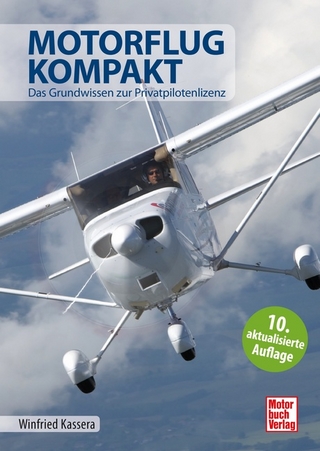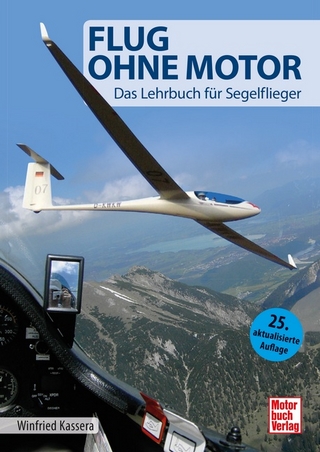
B-47 Stratojet: Boeing’s Brilliant Bomber
Seiten
2000
McGraw-Hill Professional (Verlag)
978-0-07-135567-4 (ISBN)
McGraw-Hill Professional (Verlag)
978-0-07-135567-4 (ISBN)
- Titel ist leider vergriffen;
keine Neuauflage - Artikel merken
A potrayal of the B-47 Stratojet. It takes you along on test flights, gives you the controls of nuclear-armed B-47s, and walks you into hangars to meet the crews whose work made the B-47 fly and fly again. It contains illustrations, including revealing technical diagrams, photographs and interviews with figures in aviation history.
Many say this sleek bomber prevented World War III. One thing's for sure - its breakthrough design echoes in jets to this day. 'We had both apprehension and confidence as we prepared for the first flight. I and many others did not know what was coming'. Those were the thoughts of experimental test pilot Robert Robbins as he released the brakes and prepared to take a 'truly radical airplane' aloft for the first time. It was the only time in his life Robbins ever prayed before a test flight. But the XB-47 was unlike anything he - or anyone else - had ever flown. Poised on Runway 13 of Boeing Field on the afternoon of December 17, 1947, the first-ever jet bomber looked frighteningly futuristic. Thirty-five-degree swept wings, strut-mounted jets, swept horizontal and vertical stabilizers, and a long, aerodynamic fuselage set it apart from all but the most experimental aircraft of its day. Plumes of black smoke spewed from the XB-47's six podded jet engines as the watching crowd of engineers, company officials, and family members held their breath. Would it take off, fly, and land? Robbins and fellow test pilot Scott Osler would soon find out...time travelers from today could have broken the suspense.
One glance at the aircraft would have told the story. For the XB-47's profile is echoed in nearly every commercial airliner on every runway at every airport around the world, more than 50 years after that first flight. The B-47 would go on to become the prototype for a generation of military aircraft, and more than one generation of passenger plane. It made history and set standards. In many ways, it made the Boeing company itself. And if that weren't enough, many credit the B-47 with being the major deterrent to World War III. This insightful, detailed portrayal of one of the world's most influential aircraft lets you share with its creators some of the most exciting moments in aeronautical history. Professional aviation writer and pilot Jan Tegler's "B-47 Stratojet" takes you along on heart-pounding test flights, gives you the controls of nuclear-armed B-47s, and walks you into hangars to meet the crews whose work made the B-47 fly and fly again.
Packed with illustrations, including revealing technical diagrams, color and black-and-white photographs - many never before published - and interviews with leading figures in aviation history, this consummate telling of the B-47 story is the milestone book on a turning-point aircraft. "B-47 Stratojet" will be a long-time source of pride and pleasure to anyone fortunate enough to read and own it. "B-47 Stratojet" features: more than 150 illustrations and photos showcasing B-47 design, development, systems, uses, and operation; insiders' stories of testing, evaluation, and acceptance - from labs and wind tunnels through government contracts; exciting first-hand accounts of flying this high-performance plane, the first nuclear jet bomber; and, details and photos of 'odd duck' B-47s modified for unconventional uses such as hurricane hunting. This book is part of the "Walter J. Boyne Military Aircraft Series", "The Sky Warriors of Yesterday, Today, and Tomorrow". Each volume in "The Walter J. Boyne Military Aircraft Series" provides an extensively illustrated look at America's top combat aircraft, from pre-WWII to conflicts yet to come. Internationally renowned, Walter J.Boyne is a former USAF Command Pilot and the number one aviation author.
He is also past Director of the Smithsonian Institution's National Air and Space Museum, and co-founder of Wingspan, Air and Space Channel, the first cable television channel devoted exclusively to aerospace subjects. It never gained a nickname, nor served in combat. 'One can only thank God that the B-47 never had a chance to gain such a reputation,' writes Series Editor Walter J. Boyne in his introduction to this book, 'for it was designed for nuclear warfare'. During the early years of its operational career, the B-47 was far ahead of Soviet aircraft and antiaircraft weaponry. Its certain ability to strike back effectively checked Soviet atomic capability and may indeed have prevented a shift in the course of history towards a Communist-dominated world. Ironically, the handsome, historically important B-47 bomber has a Cinderella history. Few were the early observers who saw the potential in this plane. A division of the National Advisory Committee for Aerodynamics initially rejected studies which proposed the benefits of wing sweep, the very concept which would later be adopted for the B-47's swept-wing design, dismissing them as improbable.
At Boeing itself, only a handful of people outside the experimental team had any interest in the aircraft. On the September afternoon when this advanced jet bomber was officially rolled out, Boeing workers stayed at their desks and benches, though rollout ceremonies typically lured staff out to watch and cheer. And when Air Force officials visited Boeing, they came to discuss production plans for the B-50 and to check progress on the new B-54, a compound engined bomber based on the B-29 and B-50. These were the planes - not that impractical B-47 - that everyone expected to succeed the bombers then in use. People regarded the B-47 as an oddball, an experiment. They did not see it as we do today, as the forebear of almost every plane in the sky. Finally an Air Force general was persuaded to take a look and a test ride. He was suitably impressed by the plane's breathtaking speed and performance, not to mention looks. Pilots of the time reported that their first reaction to the plane was, 'I wanna fly it!'. The first B-47 one pilot saw sported whitewall tires. Another pilot commented, 'It reminded me of sheer speed. Even when it was sitting still it looked as if it were going 100 mph'.
By the end of 1948, the Air Force had contracted for 10 B-47s, still far fewer than the number of conventional bombers it had on order. But the B-47 would not be denied. And the brilliance of its performance could not be denied. America's 'top gun', leading military test pilot Chuck Yeager was sent to follow one B-47 to clock its speed. 'I can't keep up', he radioed the jubilant B-47's civilian pilot. Journeying from Moses Lake AFB, Washington to Andrews AFB near Washington D.C. for a demonstration flight the next day, the XB-47 scorched across the country at an average of 609.8 mph, unintentionally setting a new speed record in the process. So fast that a parachute was used to help slow it down at landing, the B-47 also soon decimated the trans-Atlantic speed record. Maneuverable as well as fast, this little-noticed aircraft soon won the Air Force's devotion, going on to become the linchpin of the Strategic Air Command, and the first line of defense against the threat of Soviet atomic attack.
In "B-47 Stratojet", you can follow the remarkable story of this trend-setting bomber from its first glimmerings in the minds and eyes of designers and aerodynamicists gazing toward the future, through chilling nuclear missions in the frightening days of the Cold War, on to its astounding string of progeny predicted to fly well into the 21st Century. It's a tale any aviation buff will love, and a story whose end is not yet in sight.
Many say this sleek bomber prevented World War III. One thing's for sure - its breakthrough design echoes in jets to this day. 'We had both apprehension and confidence as we prepared for the first flight. I and many others did not know what was coming'. Those were the thoughts of experimental test pilot Robert Robbins as he released the brakes and prepared to take a 'truly radical airplane' aloft for the first time. It was the only time in his life Robbins ever prayed before a test flight. But the XB-47 was unlike anything he - or anyone else - had ever flown. Poised on Runway 13 of Boeing Field on the afternoon of December 17, 1947, the first-ever jet bomber looked frighteningly futuristic. Thirty-five-degree swept wings, strut-mounted jets, swept horizontal and vertical stabilizers, and a long, aerodynamic fuselage set it apart from all but the most experimental aircraft of its day. Plumes of black smoke spewed from the XB-47's six podded jet engines as the watching crowd of engineers, company officials, and family members held their breath. Would it take off, fly, and land? Robbins and fellow test pilot Scott Osler would soon find out...time travelers from today could have broken the suspense.
One glance at the aircraft would have told the story. For the XB-47's profile is echoed in nearly every commercial airliner on every runway at every airport around the world, more than 50 years after that first flight. The B-47 would go on to become the prototype for a generation of military aircraft, and more than one generation of passenger plane. It made history and set standards. In many ways, it made the Boeing company itself. And if that weren't enough, many credit the B-47 with being the major deterrent to World War III. This insightful, detailed portrayal of one of the world's most influential aircraft lets you share with its creators some of the most exciting moments in aeronautical history. Professional aviation writer and pilot Jan Tegler's "B-47 Stratojet" takes you along on heart-pounding test flights, gives you the controls of nuclear-armed B-47s, and walks you into hangars to meet the crews whose work made the B-47 fly and fly again.
Packed with illustrations, including revealing technical diagrams, color and black-and-white photographs - many never before published - and interviews with leading figures in aviation history, this consummate telling of the B-47 story is the milestone book on a turning-point aircraft. "B-47 Stratojet" will be a long-time source of pride and pleasure to anyone fortunate enough to read and own it. "B-47 Stratojet" features: more than 150 illustrations and photos showcasing B-47 design, development, systems, uses, and operation; insiders' stories of testing, evaluation, and acceptance - from labs and wind tunnels through government contracts; exciting first-hand accounts of flying this high-performance plane, the first nuclear jet bomber; and, details and photos of 'odd duck' B-47s modified for unconventional uses such as hurricane hunting. This book is part of the "Walter J. Boyne Military Aircraft Series", "The Sky Warriors of Yesterday, Today, and Tomorrow". Each volume in "The Walter J. Boyne Military Aircraft Series" provides an extensively illustrated look at America's top combat aircraft, from pre-WWII to conflicts yet to come. Internationally renowned, Walter J.Boyne is a former USAF Command Pilot and the number one aviation author.
He is also past Director of the Smithsonian Institution's National Air and Space Museum, and co-founder of Wingspan, Air and Space Channel, the first cable television channel devoted exclusively to aerospace subjects. It never gained a nickname, nor served in combat. 'One can only thank God that the B-47 never had a chance to gain such a reputation,' writes Series Editor Walter J. Boyne in his introduction to this book, 'for it was designed for nuclear warfare'. During the early years of its operational career, the B-47 was far ahead of Soviet aircraft and antiaircraft weaponry. Its certain ability to strike back effectively checked Soviet atomic capability and may indeed have prevented a shift in the course of history towards a Communist-dominated world. Ironically, the handsome, historically important B-47 bomber has a Cinderella history. Few were the early observers who saw the potential in this plane. A division of the National Advisory Committee for Aerodynamics initially rejected studies which proposed the benefits of wing sweep, the very concept which would later be adopted for the B-47's swept-wing design, dismissing them as improbable.
At Boeing itself, only a handful of people outside the experimental team had any interest in the aircraft. On the September afternoon when this advanced jet bomber was officially rolled out, Boeing workers stayed at their desks and benches, though rollout ceremonies typically lured staff out to watch and cheer. And when Air Force officials visited Boeing, they came to discuss production plans for the B-50 and to check progress on the new B-54, a compound engined bomber based on the B-29 and B-50. These were the planes - not that impractical B-47 - that everyone expected to succeed the bombers then in use. People regarded the B-47 as an oddball, an experiment. They did not see it as we do today, as the forebear of almost every plane in the sky. Finally an Air Force general was persuaded to take a look and a test ride. He was suitably impressed by the plane's breathtaking speed and performance, not to mention looks. Pilots of the time reported that their first reaction to the plane was, 'I wanna fly it!'. The first B-47 one pilot saw sported whitewall tires. Another pilot commented, 'It reminded me of sheer speed. Even when it was sitting still it looked as if it were going 100 mph'.
By the end of 1948, the Air Force had contracted for 10 B-47s, still far fewer than the number of conventional bombers it had on order. But the B-47 would not be denied. And the brilliance of its performance could not be denied. America's 'top gun', leading military test pilot Chuck Yeager was sent to follow one B-47 to clock its speed. 'I can't keep up', he radioed the jubilant B-47's civilian pilot. Journeying from Moses Lake AFB, Washington to Andrews AFB near Washington D.C. for a demonstration flight the next day, the XB-47 scorched across the country at an average of 609.8 mph, unintentionally setting a new speed record in the process. So fast that a parachute was used to help slow it down at landing, the B-47 also soon decimated the trans-Atlantic speed record. Maneuverable as well as fast, this little-noticed aircraft soon won the Air Force's devotion, going on to become the linchpin of the Strategic Air Command, and the first line of defense against the threat of Soviet atomic attack.
In "B-47 Stratojet", you can follow the remarkable story of this trend-setting bomber from its first glimmerings in the minds and eyes of designers and aerodynamicists gazing toward the future, through chilling nuclear missions in the frightening days of the Cold War, on to its astounding string of progeny predicted to fly well into the 21st Century. It's a tale any aviation buff will love, and a story whose end is not yet in sight.
Jan Tegler is a professional writer and broadcaster specializing in aviation. He is the author of numerous articles for domestic and international aviation publications on contemporary and historical subjects. He is also a private pilot and racecar driver.
Origins and Development. Fight Test. SAC's Speeding Bullet. B-47A. B-47B. B-47B Variants and Conversions. B-47E. B-47E Variants and Conversions. Special Variants. Conclusion. Appendices.
| Erscheint lt. Verlag | 16.6.2000 |
|---|---|
| Zusatzinfo | 153 Illustrations, unspecified |
| Sprache | englisch |
| Maße | 213 x 282 mm |
| Gewicht | 817 g |
| Themenwelt | Natur / Technik ► Fahrzeuge / Flugzeuge / Schiffe ► Luftfahrt / Raumfahrt |
| Natur / Technik ► Fahrzeuge / Flugzeuge / Schiffe ► Militärfahrzeuge / -flugzeuge / -schiffe | |
| Sozialwissenschaften ► Politik / Verwaltung | |
| ISBN-10 | 0-07-135567-7 / 0071355677 |
| ISBN-13 | 978-0-07-135567-4 / 9780071355674 |
| Zustand | Neuware |
| Haben Sie eine Frage zum Produkt? |
Mehr entdecken
aus dem Bereich
aus dem Bereich
das Grundwissen zur Privatpilotenlizenz
Buch | Hardcover (2024)
Motorbuch Verlag
39,90 €
internationales Jahrbuch der Luft- und Raumfahrt
Buch | Softcover (2023)
Mittler (Verlag)
22,95 €


